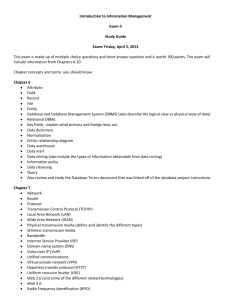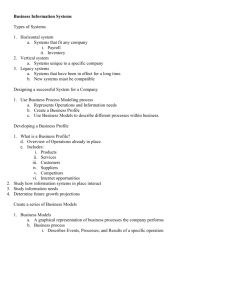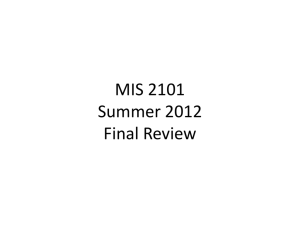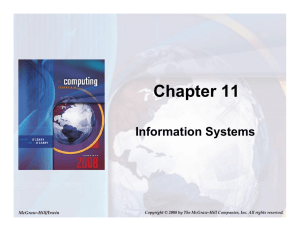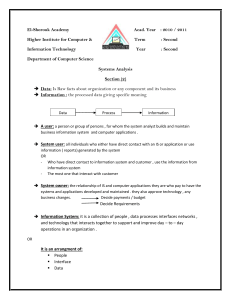Learning Objectives
advertisement
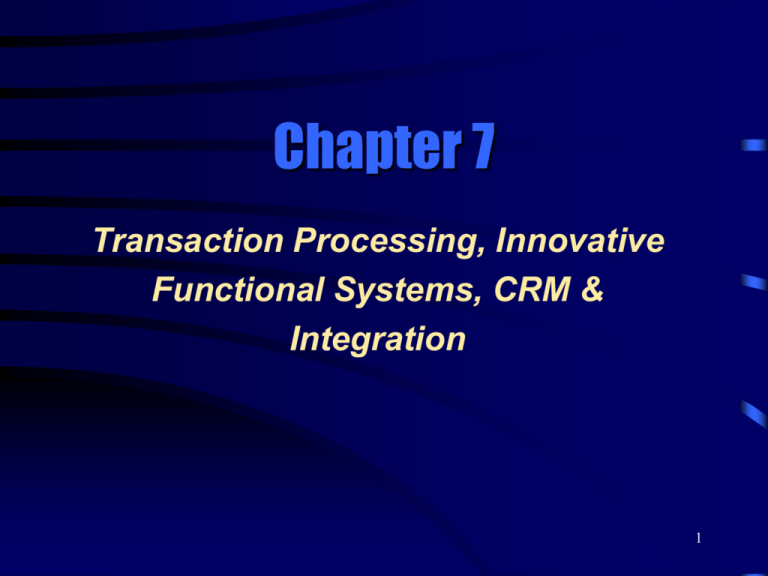
Chapter 7 Transaction Processing, Innovative Functional Systems, CRM & Integration 1 Learning Objectives Relate functional areas and business processes to the value chain model. Identify functional management information systems. Describe the transaction processing system and demonstrate how it is supported by IT. Describe the support provided by IT and the Web to each of these functional areas: production/operations, marketing and sales, accounting and finance, and human resources management. Describe the role of IT in facilitating CRM. Describe the benefits & issues of integrating functional information systems. 2 Case: Integrated Solutions for Building Supply Problem: Colonial is a small building supply company in Utah. To remain competitive, they needed a technology to provide information about inventory levels & customer buying trends. Solution: Colonial purchased an integrated system, point-of-sale (POS) terminals, hand-held automatic product identification & data collection. Sold items are deducted from the inventory instantly. Purchase orders are sent electronically via the Internet. Results: Lower costs for data entry labor, reductions in inventory/ storage space, fast access to information, better customer service, & higher employee satisfaction 3 Lessons from the Case IT supports the routine processes of a retailer, enabling it to be efficient and effective and to satisfy its customers. The software helped to modernize & redesign the company’s major business processes. The software supports several business processes, not just one. The system’s major applications are in logistics. However, the same software vendor provides ready-made accounting, marketing, & operations modules. IT can be beneficial to a relatively small company. The integration includes connection to business partners using the Internet. 4 Functional Information Systems Traditionally, information systems were designed within each functional area to increase their internal effectiveness & efficiency. This may not suit some organizations, because certain processes may involve activities that are performed in several functional areas. Solution 1: Reengineer the organization. For example, the company can create cross-functional teams, each responsible for performing a complete business process. Solution 2: The integrated approach (e.g. Colonial). Keeps the functional departments but creates a supportive information system to help communication, coordination, and control. 5 Functional Departments & the Value Chain 6 Characteristics of Functional Information Systems 1. A functional information system consists of several smaller information systems that support specific activities performed in the functional area. 2. The specific IS applications in any functional area can be integrated to form a coherent departmental functional system, or they can be completely independent. 3. Functional information systems interface with each other to form the organization-wide information system. 4. Some organizational information systems interface with the environment. 5. Information systems applications support the three levels of an organization’s activities: operational, managerial, and strategic. 7 Transaction Processing Systems Transaction Processing Systems (TPS) = “the information system that support business processes, mainly accounting & finance transactions, with some sales, personnel, & production activities as well.” TPS is the backbone of an organization’s information systems. It monitors, collects, stores, processes & disseminates information for all routine core business transactions. These data are input data to functional information systems applications, DSS, and CRM. 8 Objectives of TPS Primary goal of TPS = to provide all the information needed by law and/or by organizational policies to keep the business running properly and efficiently. Specific objectives of a TPS= to allow for efficient & effective operation of the organization. to provide timely documents and reports. to increase the competitive advantage of the corporation. to provide the necessary data for tactical & strategic systems, such as Web-based applications. to ensure accuracy & integrity of data & information. to safeguard assets & security of information. 9 Activities of TPS First, data are collected & entered into the computer via any input device. The system then processes data in one of the following ways: Batch processing= the firm collects data from transactions as they occur, placing them in groups or batches. The system then processes the batches periodically Online processing = data are processed as soon as a transaction occurs. Hybrid system (a combination of batch & online processing) collects data as they occur but process them at specified intervals. 10 Benefits of Internet Transaction Processes Flexibility to accommodate unpredictable growth in processing demand. Cost effectiveness for small dollar amounts. Interactive, automatic billing, enabling companies to offer services to anyone, not just subscribers. Timely search and analysis of large databases. Ability to handle multimedia data such as pictures and sound effectively and efficiently. High data throughput to support inquiries requiring massive file size. Fast response time. Effective storage of huge graphics and video databases. 11 Case: Taxis in Singapore Taxis in Singapore are tracked by a global positioning system (GPS). This provides users with an instant fix on the geographical position of each taxi. Customer orders are usually received via telephone, fax & e-mail. Frequent users enter orders from their offices or homes by keying in a PIN number. The system completely reengineered the taxi order processing. The transaction time for processing an order is much shorter. The system increased the capacity for taking incoming calls by 1,000%. 12 Production & Operations Management (POM) The Production and Operations Management (POM) function in an organization is responsible for the processes that transform inputs into useful outputs. Four IT-supported POM topics be discussed: In-house logistics and material management. Planning production/operations. Automating design work and manufacturing. Computer-integrated manufacturing (CIM). 13 In-House Logistics & Material Management Logistics Management deals with ordering, purchasing, inbound logistics (receiving), and outbound logistics (shipping) activities. All of these activities can be supported by information systems. For example, many companies today are moving to some type of eprocurement Inventory management determines how much inventory to keep. Three costs play important roles in inventory decisions: cost of maintaining inventories cost of ordering (a fixed cost per order) cost of not having inventory when needed. 14 Planning Procedures/ Operations Material Requirements Planning (MRP) = The software that facilitates the plan for acquiring (or producing) parts, subassemblies, or materials. Manufacturing Resource Planning (MRP II) = connects the regular MRP to other functional areas. In addition to the output similar to that of MRP, MRP II determines the costs of parts and the cash flow needed to pay for parts. Just-in-time (JIT) = an approach that attempts to minimize waste of all kinds (space, labor, materials, energy, and so on) and continuously improve processes and systems. 15 Planning Procedures/ Operations (cont.) The management of a project is complicated by the following characteristics: Most projects are unique undertakings, and participants have little prior experience in the area. Uncertainty exists due to the long completion times. There can be significant participation of outsiders, which is difficult to control. Extensive interaction may occur among participants. Projects often carry high risk but also high profit potential. 16 Automated Design Work & Manufacturing Computer-aided design (CAD) is a system that enables industrial drawings to be constructed on a computer screen & stored, manipulated & updated electronically. Computer-Aided Manufacturing (CAM) encompasses computeraided techniques that facilitate planning, operation & control of a production facility. Computer-aided engineering (CAE) software enables designers to analyze the design and determine whether it will work the way the designer thought it would. Enhanced product realization (EPR) is a Web-based, distributed system that allows manufacturers to make product modifications anywhere in the world in as few as five days. 17 Computer-Integrated Manufacturing (CIM] Computer-integrated manufacturing (CIM) is a philosophy about the implementation of various integrated computer systems in factory automation. 18 Computer-Integrated Manufacturing (CIM] Computer-integrated manufacturing (CIM) has three basic goals; Simplification of all manufacturing technologies & techniques. Automation of as many of the manufacturing processes as possible by the integration of many information technologies. Integration and coordination of all aspects of design, manufacturing & related functions via computer hardware and software. 19 The CIM Model 20 Channel Systems CHANNEL SYSTEMS are all the systems involved in the process of getting a product or service to customers & dealing with all customers’ needs. FOUR MAIN CHANNEL SYSTEM ACTIVITIES: The Customer is King/ Queen. Telemarketing. Distribution channels. Marketing management. 21 The Customer is King/ Queen Innovative products & services and superb customer service are becoming a necessity for many organizations. For example; It is essential for companies today to be aware of their customers and treat them like royalty. Customer Profiles and Preference Analysis. Prospective Customer Lists & Marketing Databases. Mass Customization. Personalization. 22 Telemarketing & Online Shopping Lately, telemarketing has been moving to cell phones, using Short message service (SMS), which consists of messages you can receive on your cell phone. A telemarketing process can be divided into five major activities, all of which are supported by IT & can be done on the Web, even in a wireless environment. Advertisement and reaching customers Order processing Customer service Sales support Account management 23 Distribution Channels Organizations can distribute their products & services through several available delivery channels. A company may use its own outlets or distributors. The company also needs to decide on the delivery mode (trains, planes, trucks). Distribution Channels Management. Once products are in the distribution channels, firms need to monitor and track them to guarantee customer satisfaction. Improving Sales at Retail Stores. Using information technology, it is possible to improve sales by reengineering the checkout process. 24 Marketing Management Many marketing management activities are supported by computerized information systems. Some areas where this is being done include; Pricing of Products or Services. Salesperson Productivity. Productivity Software (Sales automation software) Product-Customer Profitability Analysis. Sales Analysis and Trends. New Product, Service, and Market Planning. Web-Based Systems in Marketing. 25 Managing Accounting & Finance Systems 26 Managing Accounting & Finance Systems An accounting/finance information system is responsible for: Gathering the raw data necessary for the accounting/finance TPS Ttransforming the data into information Making the information available to users Many packages exist to execute routine accounting transaction processing activities. Some software packages are integrated, e.g. MAS 90 and MAS 200 The accounting/finance TPS also provides a complete, reliable audit trail of all transactions transmitted through the network. 27 Financial Planning & Budgeting Appropriate management of financial assets is a major task in financial planning and budgeting. Financial and Economic Forecasting. Knowledge about the availability and cost of money is a key ingredient for successful financial planning. Planning for Incoming Funds. Funds for organizations come from several sources. Using the information generated by financial and economic forecasts, the organization can build a decision support model for planning incoming funds. 28 Investment Management Investment management is a difficult task for the following reasons: 1. There are thousands of investment alternatives. 2. Investment decisions are based on economic and financial forecasts, which are frequently unreliable. 3. The investment environment includes opportunities in other countries, providing both high potential rewards and high risks. 4. Investments made by many organizations are subject to complex regulations and tax laws. 5. Investment decisions need to be made quickly & frequently. 6. Several multiple and conflicting objectives exist in making investments, including high yield, safety, and liquidity. 29 CASE: Equity Portfolios at Daiwa Securities Daiwa Securities of Japan is one of the world’s largest and most profitable multinational securities firms. They believe that identifying mispricings in the stock markets holds great profit potential. Daiwa uses leading-edge computerized quantitative analysis which compares stock price performance of individual companies to that of other companies in the same market sector. The recommendations are generated by a system called MATLAB. MATLAB attempts to minimize the risk of the portfolio yet maximize its profit. 30 Access to Financial & Economic Reports To cope with the large amount of financial online data, investors use three supporting tools: Internet search engines for finding financial data. Internet directories and yellow pages. Software for monitoring, interpreting, analyzing financial data, & alerting management. 31 Control & Auditing Specific forms of financial control are; Budgetary controls Internal and External audits Financial Ratio Analysis Profitability Analysis &Cost Control Product Pricing 32 Managing Human Resource Systems Developments in Web-based systems increased the popularity of human resources information systems (HRISs) as of the late 1990s. Initial HRIS applications were mainly related to transaction processing systems. However, in the last decade we have seen considerable computerization activities in the managerial and even strategic areas. 33 HRISs & Recruitment Using the Web for Recruitment. With millions of resumes available online, companies are trying to find appropriate candidates on the Web. Position Inventory. Large organizations need to fill vacant positions frequently. An advanced intranet-based position inventory system keeps the position inventory list current & matches openings. Employee Selection. To expedite the testing and evaluation process and ensure consistency in selection, companies use information technologies such as expert systems. 34 Human Resources Maintenance & Development Performance Evaluation. Once digitized, evaluations can be used to support many decisions, ranging from rewards to transfers to layoffs. Training and Human Resources Development. IT can support the planning, monitoring, and control of training and retraining activities by using workflow applications. Intelligent computer-aided instruction (ICAI) and application of multimedia support for instructional activities. Training can be improved using Web-based video clips & virtual reality. 35 Human Resources Planning & Management Personnel Planning. Large companies develop qualitative and quantitative workforce planning models, which can be enhanced if IT is used to collect, update, and process the information. Labor–Management Negotiations. Some companies have developed computerized DSS models that support negotiations. These models can simulate financial & other impacts of fulfilling any demand made by employees and provide answers to queries in seconds. Benefits Administration. Using computers for benefits selection can save a tremendous amount of labor and time. Some companies have automated benefits enrollments. 36 Customer Relationship Management Customer relationship management (CRM) is an approach that recognizes that customers are the core of the business and that the company’s success depends on effectively managing relationships with them. Relationship marketing is the “overt attempt of exchange partners to build a long-term association, characterized by purposeful cooperation and mutual dependence on the development of social, as well as structural, bonds” (Mowen & Minor, 1998). Customer service is a series of activities designed to enhance the level of customer satisfaction. E-Service is customer service that is performed on the Web, sometimes automatically. 37 CRM in Action According to Seybold and Marshak (1998) there are five steps in building IT-supported CRM. These are: 1. 2. 3. 4. 5. Make it easy for customers to do business with you. Focus on the end customer for your products and services. Redesign your customer-facing business processes from the end customer’s point of view. Wire your company for profit: design a comprehensive, evolving electronic business architecture. Foster customer loyalty. In e-Commerce, especially, this is the key to profitability. 38 Information Technology in CRM 39 Customer Service on the Web Providing Search and Comparison Capabilities. Providing Free Products and Services. Allowing Customers to Order Customized Products and Services Online. Letting Customers Track Accounts or Order Status Providing Technical and Other Information and Service. 40 Tools for Customer Service Personalized Web Pages E-mail and Automated Response FAQs Tracking Tools Help Desks and Call Centers Chat Rooms Troubleshooting Tools 41 Justifying CRM programs One way to determine how much customer service to provide is to compare your company against a set of standards known as metrics. Metrics to evaluate Web-related customer service: Response time. Site availability. Download time. Timeliness. Security and privacy. Fulfillment. Return policy. Navigability. 42 CRM Failures A large percentage of failures have been reported in CRM. Some of the big issues are; Failure to identify and focus on specific business problems. Lack of active senior management (non-IT) sponsorship. Poor user acceptance, which can occur for a variety of reasons such as unclear benefits and usability issues. Trying to automate a poorly defined process. 43 Partner Relationship Management Partnership Relationship Management (PRM) refers to all of the efforts made to apply CRM to all types of business partners. Specific functions of PRM applications: Partner profiles Partner communications Lead management Targeted information distribution Connecting the extended enterprise Centralized forecasting Group planning E-mail/ Web-based alerts Messaging Price lists Partner planning Community bulletin boards 44 Case: Integrated Server System at Europcar Problem: Europcar Internet, the largest European-based car rental agency, combined 55 different mainframe and minicomputer systems into a single client/server center known as Greenway. The 55 independent systems needed to be integrated. Solution: Key business processes were all integrated into Greenway. Customer-related benefits include (1) faster service (2) reservation desks linked to airline reservation systems, and (3) corporate customers managed from one location. Results: By 2000, Europcar expanded to 100 countries worldwide. 45 Managerial Issues Integration of functional information systems. Integration of existing standalone functional information systems is a major problem for many organizations. Priority of transaction processing. Transaction processing may not be an exotic application, but it deals with the core processes of organizations. The customer is king/queen. In implementing IT applications, management must remember the importance of the customer, whether external or internal. 46 Managerial Issues (cont.) Finding innovative Using the Web. Web-based applications. Tools such as systems should be considered Lotus Notes, intranets, and the in all functional areas. They are Internet enable the construction effective, inexpensive & user of many applications that can friendly. increase productivity and quality. System integration. Although functional systems are necessary, they may not be sufficient if they work independently. Ethical Issues. Many ethical issues are related to the code of ethics followed in CRM and privacy policies. 47

